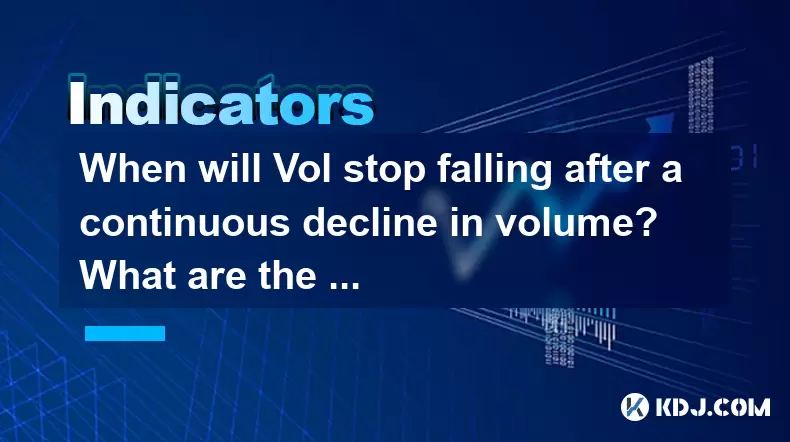-
 bitcoin
bitcoin $112195.049338 USD
2.42% -
 ethereum
ethereum $4124.915858 USD
2.81% -
 tether
tether $1.000570 USD
0.02% -
 xrp
xrp $2.861568 USD
2.25% -
 bnb
bnb $1000.346670 USD
3.04% -
 solana
solana $209.070819 USD
3.38% -
 usd-coin
usd-coin $0.999870 USD
0.02% -
 dogecoin
dogecoin $0.235379 USD
2.65% -
 tron
tron $0.335681 USD
-0.20% -
 cardano
cardano $0.803501 USD
3.38% -
 hyperliquid
hyperliquid $47.120881 USD
3.56% -
 chainlink
chainlink $21.501300 USD
3.44% -
 ethena-usde
ethena-usde $1.000571 USD
0.02% -
 avalanche
avalanche $29.793378 USD
3.62% -
 stellar
stellar $0.366964 USD
2.42%
When will Vol stop falling after a continuous decline in volume? What are the signals?
Volume might stop falling when technical patterns like volume spikes or double bottoms appear, alongside positive news and shifts in market sentiment.
May 22, 2025 at 10:02 am

In the cryptocurrency market, understanding the trajectory of trading volume is crucial for investors and traders looking to make informed decisions. Volume, often referred to as 'Vol,' is a key indicator of market activity and liquidity. A continuous decline in volume can signal various market conditions, and knowing when this decline might stop is essential for strategizing trades. This article delves into the indicators and signals that suggest when volume might stop falling and what these signals mean for the market.
Understanding Volume and Its Importance
Volume in the context of cryptocurrencies refers to the total number of coins or tokens traded within a specific timeframe. It is a critical metric because it provides insights into the strength and sustainability of price movements. When the volume is high, it indicates strong market interest and liquidity, making it easier to buy or sell assets without significantly affecting the price. Conversely, a continuous decline in volume can signal waning interest or a potential shift in market dynamics.
Factors Contributing to Declining Volume
Several factors can contribute to a continuous decline in volume. Market sentiment plays a significant role; if investors are bearish or uncertain, they may trade less frequently, leading to lower volumes. Additionally, seasonal trends and external economic factors can influence trading activity. For instance, during holiday seasons or periods of economic uncertainty, trading volumes may naturally decline.
Identifying When Volume Might Stop Falling
Recognizing when volume might stop falling involves observing various technical and fundamental indicators. Here are some key signals to watch for:
Reversal Patterns in Technical Analysis
Technical analysis can provide early signals of a potential reversal in volume trends. Volume spikes after a period of decline can indicate that market participants are re-entering the market, possibly due to a change in sentiment or new information. Chart patterns such as double bottoms or head and shoulders can also signal a potential reversal in volume. These patterns, when accompanied by increasing volume, suggest that the market is gaining momentum.
Fundamental Developments
Fundamental developments in the cryptocurrency space can also signal when volume might stop falling. Positive news, such as regulatory clarity, technological advancements, or partnerships, can boost investor confidence and lead to increased trading activity. Conversely, negative news can continue to suppress volume, but a resolution or positive turn in these events can signal a reversal.
Market Sentiment Indicators
Market sentiment indicators, such as the Fear and Greed Index or social media sentiment analysis, can provide insights into when volume might stop falling. A shift from fear to greed or positive social media sentiment can indicate that traders are becoming more active, potentially leading to increased volume.
Volume Oscillators and Indicators
Using volume oscillators and indicators can help identify when volume might stop falling. The On-Balance Volume (OBV) indicator measures buying and selling pressure by adding volume on up days and subtracting it on down days. A rising OBV after a period of decline can suggest that volume is about to increase. The Volume Rate of Change (VROC) indicator measures the rate at which volume is changing, and a positive shift in VROC can signal that volume is picking up.
Practical Steps to Monitor Volume Trends
To effectively monitor volume trends and identify when volume might stop falling, traders can follow these practical steps:
Use Trading Platforms with Volume Data: Ensure that your trading platform provides real-time volume data. Platforms like Binance, Coinbase, and TradingView offer detailed volume charts and indicators.
Set Up Alerts: Configure alerts on your trading platform to notify you of significant volume changes. For example, set an alert for a volume spike of 20% above the recent average.
Analyze Volume alongside Price: Always analyze volume in conjunction with price movements. A price increase with increasing volume is a stronger bullish signal than a price increase with declining volume.
Utilize Technical Analysis Tools: Incorporate technical analysis tools such as moving averages, RSI, and MACD to complement your volume analysis. These tools can help confirm volume signals and provide additional context.
Stay Informed on Fundamental News: Keep abreast of fundamental news and developments in the cryptocurrency space. Subscribe to reputable news sources and follow key opinion leaders on social media to stay informed.
Case Studies of Volume Reversals
Examining past case studies can provide valuable insights into how volume reversals have occurred in the cryptocurrency market. For instance, Bitcoin's volume reversal in early 2021 was preceded by a period of declining volume. A combination of positive regulatory news and institutional adoption led to a significant increase in trading volume, signaling a strong bullish trend.
Another example is Ethereum's volume reversal in mid-2020, which was driven by the growing interest in decentralized finance (DeFi) and the subsequent launch of Ethereum 2.0. The anticipation of these developments led to a gradual increase in volume, indicating a shift in market dynamics.
Interpreting Volume Signals in Different Market Conditions
Interpreting volume signals can vary depending on the overall market conditions. In a bull market, increasing volume can confirm the strength of the uptrend, while in a bear market, increasing volume might indicate capitulation or a potential bottom. Understanding the broader market context is essential for accurately interpreting volume signals.
In a sideways market, volume signals can be more nuanced. A sudden increase in volume might signal a breakout or breakdown, while sustained low volume can indicate a lack of market interest and potential for continued consolidation.
Frequently Asked Questions
1. Can volume alone predict price movements in cryptocurrencies?Volume alone cannot predict price movements with certainty, but it is a valuable indicator that should be used in conjunction with other technical and fundamental analysis tools. High volume can confirm the strength of a price trend, while low volume might suggest a lack of conviction in the current price movement.
2. How does the time of day affect cryptocurrency volume?Cryptocurrency volume can vary significantly depending on the time of day, with higher volumes typically observed during peak trading hours in major financial markets. For instance, trading volumes often increase during the overlap of the Asian, European, and North American trading sessions.
3. What role do market makers play in influencing volume?Market makers can influence volume by providing liquidity and facilitating trades. Their activities can lead to increased volume, especially in less liquid markets. However, their impact is more pronounced in traditional financial markets than in the decentralized nature of cryptocurrencies.
4. How can retail traders impact volume trends?Retail traders can significantly impact volume trends, especially in smaller cryptocurrencies. Their collective buying and selling decisions can lead to volume spikes or declines, particularly during periods of high market volatility or in response to news and events.
Disclaimer:info@kdj.com
The information provided is not trading advice. kdj.com does not assume any responsibility for any investments made based on the information provided in this article. Cryptocurrencies are highly volatile and it is highly recommended that you invest with caution after thorough research!
If you believe that the content used on this website infringes your copyright, please contact us immediately (info@kdj.com) and we will delete it promptly.
- News, September 28th, Headlines: Crypto's Wild Ride
- 2025-09-29 20:45:13
- Altcoins, Investors, and Potential Gains: Riding the 2025 Crypto Wave
- 2025-09-29 20:45:13
- Citi Token Services: Revolutionizing Cross-Border Payments and Liquidity Management
- 2025-09-29 20:50:01
- JYAI Token Gears Up for Launch: LCX Exchange Listing Imminent
- 2025-09-29 20:50:01
- Prenetics, Bitcoin Holdings, and Corporate Bitcoin: A New Era?
- 2025-09-29 20:25:11
- Swift, Altcoins, and Shifting Sands: Diving into Crypto's Latest Details
- 2025-09-29 20:25:11
Related knowledge

What is a tower bottom candlestick pattern? Does it have a high success rate?
Sep 22,2025 at 07:18am
Tower Bottom Candlestick Pattern Explained1. The tower bottom candlestick pattern is a reversal formation that typically appears at the end of a downt...

What is a black hole pattern in the MACD indicator? Is it a cause for concern?
Sep 21,2025 at 06:54pm
Bitcoin's Role in Decentralized Finance1. Bitcoin remains the cornerstone of decentralized finance, serving as a benchmark for value and security acro...

How can I use the psychological line (PSY) to determine market sentiment?
Sep 17,2025 at 02:19pm
Understanding the Psychological Line (PSY) in Cryptocurrency TradingThe Psychological Line, commonly referred to as PSY, is a momentum oscillator used...

How can I determine if a double top pattern has officially formed?
Sep 21,2025 at 03:18am
Understanding the Structure of a Double Top Pattern1. A double top pattern consists of two distinct peaks that reach approximately the same price leve...

What is the Golden Valley pattern on the moving average? Is it better than the Silver Valley pattern?
Sep 21,2025 at 02:54pm
Understanding the Golden Valley Pattern in Moving Averages1. The Golden Valley pattern is a technical formation observed in cryptocurrency price chart...

What does a death cross of the RSI in the strong zone (above 50) mean?
Sep 17,2025 at 10:54pm
Understanding the Death Cross in RSI Context1. The term 'death cross' is traditionally associated with moving averages, where a short-term average cro...

What is a tower bottom candlestick pattern? Does it have a high success rate?
Sep 22,2025 at 07:18am
Tower Bottom Candlestick Pattern Explained1. The tower bottom candlestick pattern is a reversal formation that typically appears at the end of a downt...

What is a black hole pattern in the MACD indicator? Is it a cause for concern?
Sep 21,2025 at 06:54pm
Bitcoin's Role in Decentralized Finance1. Bitcoin remains the cornerstone of decentralized finance, serving as a benchmark for value and security acro...

How can I use the psychological line (PSY) to determine market sentiment?
Sep 17,2025 at 02:19pm
Understanding the Psychological Line (PSY) in Cryptocurrency TradingThe Psychological Line, commonly referred to as PSY, is a momentum oscillator used...

How can I determine if a double top pattern has officially formed?
Sep 21,2025 at 03:18am
Understanding the Structure of a Double Top Pattern1. A double top pattern consists of two distinct peaks that reach approximately the same price leve...

What is the Golden Valley pattern on the moving average? Is it better than the Silver Valley pattern?
Sep 21,2025 at 02:54pm
Understanding the Golden Valley Pattern in Moving Averages1. The Golden Valley pattern is a technical formation observed in cryptocurrency price chart...

What does a death cross of the RSI in the strong zone (above 50) mean?
Sep 17,2025 at 10:54pm
Understanding the Death Cross in RSI Context1. The term 'death cross' is traditionally associated with moving averages, where a short-term average cro...
See all articles


























![[Pycoin] PI Coin -Shocking Listance of Pycoin?! 'Rebellion' This time ... Pay attention to #paikoin [Pycoin] PI Coin -Shocking Listance of Pycoin?! 'Rebellion' This time ... Pay attention to #paikoin](/uploads/2025/09/29/cryptocurrencies-news/videos/pycoin-pi-coin-shocking-listance-pycoin-rebellion-time-pay-attention-paikoin/68da82f23cec1_image_500_375.webp)















































